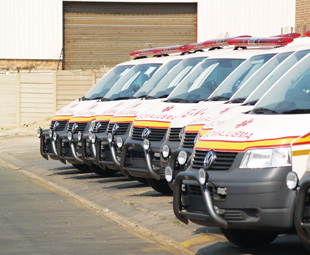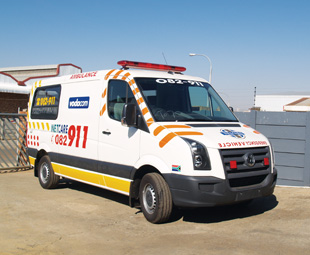Arriving alive…at the nearest hospital

Christmas 2010, and the New Year and Easter seasons that follow in 2011 will again highlight how capable and well-equipped – or not – South Africa’s emergency services are for dealing with people who will be injured in crime and calamity cases, writes UDO RYPSTRA.
Crime puts a lot of people in hospital. So do calamities, with people being injured to all degrees through “Acts of God” (or acts of man) such as floods, tidal waves, earth quakes, epidemics and fires.
South Africa is going through another silly, if not horrible, five-month season interspersed with long (holiday) weekends during April. Holidaymakers will have to be saved from drowning and injured mountaineers will have to be carried or lifted to waiting ambulances or helicopter pads.
Last, but definitely not least, another Arrive Alive campaign is already in full swing to reduce road accidents and the number of people who are fatally injured or maimed for life in road crashes, leaving hundreds of spouses and children penniless, in another kind of living hell, if not bereft of a decent future.
Arriving alive at home is one thing. What about the right to arrive alive at the nearest hospital?
In South Africa, health care excellence for all is a constitutional right. Crucial to the health care service delivery in any city or province, is access to emergency rescue and medical services (EMS), even if that means arriving alive on a stretcher at the nearest hospital.
In this, the fire engine, with its jaws of life (many firemen are also qualified paramedics), the ambulance and the rescue helicopter play the most vital roles.
In my first 20 years as a crime, calamity, court and medical reporter, I saw people who became injured or wounded at home, in the street or in riots, and emergency vehicles subsequently being summoned. Sometimes, the ambulance arrived promptly. Sometimes it took hours, with someone’s car doing the emergency dash in the end.
 I have accompanied Cape paramedics on their Christmas and New Year shifts, heard them swear, and saw one cry because of faulty equipment, and seen them finally drop wounded but drunken patients off at overcrowded Groote Schuur and Woodstock hospital casualty wards.
I have accompanied Cape paramedics on their Christmas and New Year shifts, heard them swear, and saw one cry because of faulty equipment, and seen them finally drop wounded but drunken patients off at overcrowded Groote Schuur and Woodstock hospital casualty wards.
I have heard advocates state in civil high courts that one of the biggest challenges of health authorities is to achieve emergency response times within the national norms of 15 minutes in urban areas and 40 minutes in rural areas.
I have heard doctors testify that death or injury complications could have been prevented, and that pain, suffering, loss of amenities, future medical costs and loss of earnings (all part of the civil damages claim) could have been reduced had the fire engine or ambulance arrived in time.
The excuse was often that either there were not enough emergency vehicles available or that they were not operational anymore.
This amounts to bad planning and bad maintenance practices, as well as bad security measures, considering that a number of ambulances bought by provinces for South Africa to be ready for any World Cup emergencies have “disappeared”.
The past 20 years in transport journalism have taught me that South Africa is blessed by having access to state-of-the-art emergency vehicles, with base vehicles provided by the country’s vibrant vehicle manufacturing industry. More importantly, it has specialist companies qualified in converting basic vehicles – pickups, panel vans and trucks – into ambulances, mobile clinics and fire engines. And they do it well.
Obviously, crew and patient safety are always of utmost importance. All surfaces must be easily washable for optimum infection control and all components used and manufactured must be of the highest quality available. For example, only the latest LED technology emergency warning devices are used.
Undoubtedly the most popular base vehicle in South Africa is the zippy Mercedes-Benz Sprinter. Recently this vehicle, encompassing the Sprinter 309 CDI, 315 CDI and 318 CDI panel van, once again passed the stringent SANS regulated rollover tests – SANS 1563 specification – primarily to test the strength of the superstructures for roll-over protection.
The unit tested was also fitted with the latest example of the mandatory roof escape hatch that has to be fitted to all TRP taxi conversions.
“Mercedes-Benz Vans once again showed our commitment towards the importance of active and passive safety, and the importance of safety in public transportation,” said Nicolai Berger, divisional manager, MBSA Vans Division.
The Sprinter’s outstanding safety is based partly on measures that reduce the risk of accidents (safe handling, effective braking and intelligent driver assistance systems like Adaptive ESP), and partly on a high-strength passenger safety cell. The Sprinter has a very stiff body structure to preserve the occupant survival space in the event of an accident. The strength of the Sprinter is exemplified by the A and B pillars, whose internal structure is made of high-tensile steel, in line with internal Mercedes-Benz accident safety requirements. This goes far beyond the statutory safety requirements.
Sophisticated conversions
South Africa’s conversion industry is very sophisticated and will design ambulances based on the client’s specific needs and environment, whether it’s for in-city, intercity or for a whole province, such as the Northern Cape, where the population is sparsely distributed with towns situated great distances from each other. Some towns are linked only by gravel roads.
 This geographic reality presents an enormous challenge to efficient EMS, and for ambulance converters. With tender specifications changing all the time, there are a variety of conversion options including basic, intermediate and advanced life-support ambulances.
This geographic reality presents an enormous challenge to efficient EMS, and for ambulance converters. With tender specifications changing all the time, there are a variety of conversion options including basic, intermediate and advanced life-support ambulances.
Top converters are: EVC (Emergency Vehicle Converters), the suppliers to Netcare, Bustruck of Johannesburg, and the KwaZulu-Natal-based Capilano Industries. All follow strict procedures laid down by the main vehicle manufacturers not to damage the base vehicle, especially the wiring harness, so as to ensure its warranty remains intact.
Considering the equipment that can be required for installation, this is a heavy responsibility. For example, apart from all the emergency lights, ambulance layouts can include many options: a self-loading stretcher or dual stretcher, squad bench, equipment cabinets, attendant seating, hand-wash basins, power inverters and built-in suction units.
Generally, the industry offers three types of ambulances:
The large van type:
According to EVC, these are ideally suited for long distance transfers, mobile intensive care units (MICU) or high-care environments, and motor vehicle accidents. Benefits of large van type ambulances include crew comfort, increased storage capabilities, increased working space, speed, visibility, design and layout flexibility.
EVC’s larger ambulances are based on the VW Crafter, Mercedes Sprinter, Iveco, Peugeot Boxer and Nissan Interstar. Four-wheel drive base vehicles are available in this category and more than one stretcher patient can be transported comfortably. Different stretcher options and layouts are available.
The small van type:
These are based on the VW T5 Transporter, Toyota HiAce and Quantum, and Mercedes Vito. They are ideally suited for a high density urban environment with high traffic volumes. Benefits of small van type ambulances include manoeuvrability, speed, height clearance, low operating costs and only a standard “car” driver’s licence is required.
Four-wheel drive base vehicles are available in this category for conversion to an ambulance.
The LCV type:
This vehicle is suited for patient transportation in a rugged environment. According to EVC, a complete ambulance body can be fitted to most long wheel-base LCV chassis. A variety of interior conversion options are available to suit a customer’s specific needs. Single or double lift-in type stretchers can be fitted to either side of the ambulance body. Emergency warning devices are surface mounted to avoid damage. Double rear doors are fitted to ensure easy access to the patient compartment. A sliding window is fitted between the patient compartment and driver cab for communication.
Mobile clinics
The industry is also involved in the conversion of mobile clinics, mobile consulting rooms, treatment facilities and primary healthcare clinics. EVC builds these clinics on either a van-type base vehicle, or places a body on an LCV chassis.
Again, a large number of options are available including generators, awnings, fridges, medical equipment and wash basins. The layout of the mobile clinic can include a separate administrative consultation room and treatment room. Mobile clinics for dentistry, ophthalmics and audiology are also available.
Published by
Focus on Transport
focusmagsa



